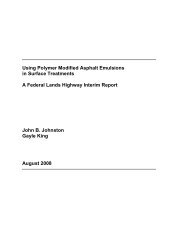An Evaluation of MoDOT's Current Coatings Programs Final ... - TSP2
An Evaluation of MoDOT's Current Coatings Programs Final ... - TSP2
An Evaluation of MoDOT's Current Coatings Programs Final ... - TSP2
You also want an ePaper? Increase the reach of your titles
YUMPU automatically turns print PDFs into web optimized ePapers that Google loves.
Hazardous Metals<br />
The presence <strong>of</strong> lead or other toxic metals in paint can significantly increase the cost <strong>of</strong><br />
repairing an existing coating if special provisions for containment and worker protection<br />
are required. A cost multiplier <strong>of</strong> 2 is typically used when lead or other hazardous<br />
metals are present, although this multiplier can be adjusted. The presence <strong>of</strong><br />
hazardous metals in the paint is established based on discussions or research about<br />
the structure history, through use <strong>of</strong> field Lead Check swabs, and/or through paint chip<br />
sampling and laboratory analysis.<br />
Phase 2 – Physical Tests <strong>of</strong> Coating Integrity<br />
Physical tests <strong>of</strong> coating thickness and adhesion are generally made on structures<br />
which are in the B or better condition. On these structures, overcoating may be an<br />
option. These tests are necessary in order to determine whether the existing coating is<br />
<strong>of</strong> sufficient integrity to be overcoated (i.e., whether it can support additional coats).<br />
While this testing can be done anytime, on large projects, it is better to delay it until the<br />
specific areas that will be overcoated are identified. In this way, the amount <strong>of</strong><br />
destructive testing is limited to those surfaces where it is applicable, and the testing is<br />
current. For example, adhesion tests today on coatings that will not be overcoated for<br />
two years are not relevant. To be accurate, the testing should be repeated at that time.<br />
Further, MODOT may wish to overcoat certain surfaces for aesthetics only, rather than<br />
to arrest corrosion. If those items exhibited only a limited amount <strong>of</strong> visible corrosion<br />
during the initial survey, testing would not have been triggered.<br />
When the testing is performed, coating thickness is measured using non-destructive,<br />
magnetic dry film thickness gages calibrated on National Institute <strong>of</strong> Standards and<br />
Technology (NIST) calibration plates. Typically, a PosiTector® 6000 is used. This<br />
assessment provides the thickness <strong>of</strong> all coats combined.<br />
Adhesion tests are conducted at random locations in accordance with Method A <strong>of</strong><br />
ASTM D3359, “Measuring Adhesion by Tape Test.” Method A requires scribing an “X”<br />
through the coating with a sharp knife followed by the application and removal <strong>of</strong> a<br />
pressure sensitive tape. The amount <strong>of</strong> coating removed in the test area is evaluated<br />
using an ASTM rating scale. Ratings <strong>of</strong> 0A and 1A typically represent poor adhesion,<br />
2A and 3A moderate adhesion, and 4A and 5A good adhesion.<br />
Risk <strong>of</strong> Overcoating<br />
The physical test results from the field investigation are factored into the decision<br />
considerations to determine the risk <strong>of</strong> applying additional coats to the existing system.<br />
The risks can be calculated and defined as follows:<br />
96
















